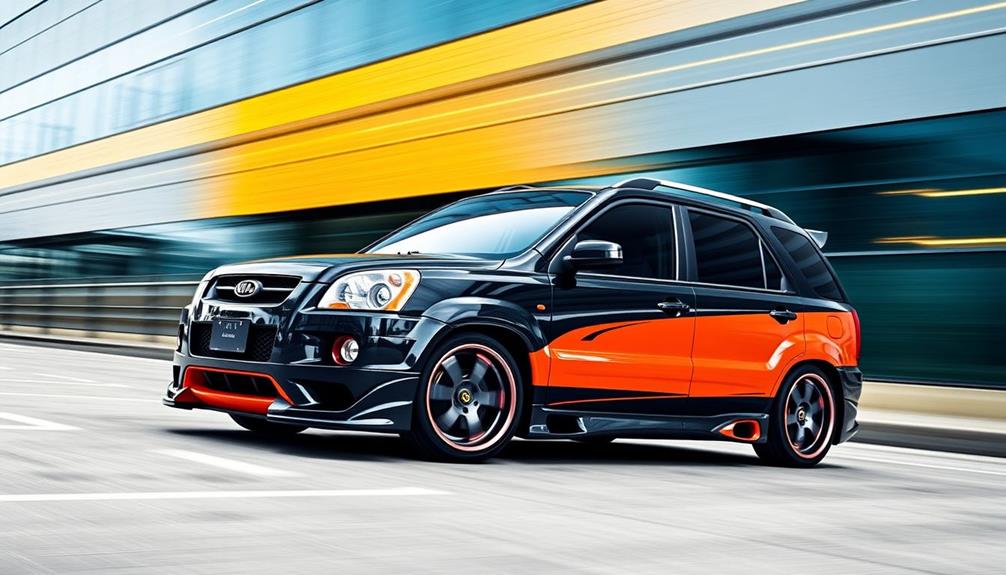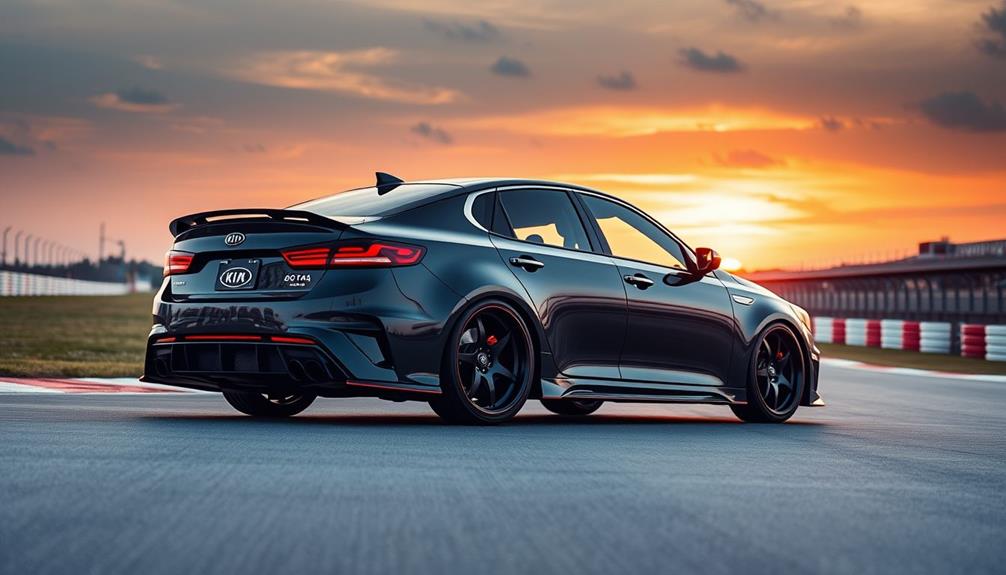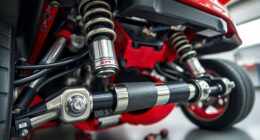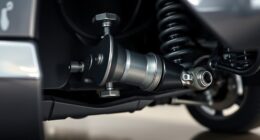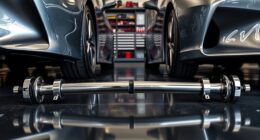Tuning your Kia Stinger 3.3 can truly elevate its performance, turning it into a thrilling powerhouse. Start with upgrades like an HnN Typhoon air intake and MBRP exhaust system for better airflow and power. ECU tuning is essential to maximize these modifications. Don't forget to use high-octane fuel—91 octane or above—to fully optimize your setup. Many enthusiasts have reported impressive horsepower gains, often exceeding 400 WHP with the right combination of parts. Connect with fellow owners for tips and insight, because there's so much more to discover about revealing your Stinger's potential.
Key Takeaways
- Upgrade to an HnN Typhoon air intake for improved airflow and combustion efficiency, enhancing overall engine performance.
- Install an MBRP exhaust system to reduce back pressure and achieve a more aggressive engine sound while boosting power.
- Utilize Ultimate Performance Downpipes and proper ECU tuning for significant horsepower gains, aiming for over 400 WHP with modifications.
- Prioritize using 91 octane or higher fuel to maximize performance and tuning effectiveness from your modifications.
- Engage with the tuning community for insights and recommendations on modifications, ensuring compatibility and optimal performance outcomes.
Overview of Kia Stinger 3.3
The Kia Stinger 3.3 stands out in the sports sedan market thanks to its powerful 3.3L V6 twin-turbo engine, delivering around 362 hp at the flywheel. This impressive output positions the Stinger 3.3 as a formidable competitor, especially when you compare it to the VF Series One 6L V8 Commodore.
Introduced in 2017, it fills the void left by the Holden and Ford sports sedans in Australia, offering a stylish and capable alternative.
One of the key features of the Kia Stinger 3.3 is its all-wheel-drive (AWD) system, which enhances traction and stability. This makes it an ideal choice for various driving conditions, whether you're tackling winding roads or cruising on highways.
The Stinger's performance isn't just about raw power; it's also about handling and driving dynamics that elevate your experience behind the wheel.
With the right tuning and modifications, you can push the Stinger 3.3's potential even further, aiming to exceed 400 WHP. This makes it a versatile platform for enthusiasts who crave performance without sacrificing everyday usability.
Performance Modifications

When it comes to boosting the Kia Stinger 3.3's performance, several modifications can take your driving experience to the next level. One of the most effective upgrades is the installation of HnN Typhoon air intakes, which greatly enhance airflow, vital for engine performance.
Pairing this with an MBRP exhaust system can further amplify your car's power, providing a more aggressive sound and improved exhaust flow.
Consider incorporating Ultimate Performance Downpipes along with a proper tune, as this combination can lead to impressive gains, potentially reaching less than 400 WHP with all-wheel drive.
However, to maximize the benefits of these upgrades, don't forget to access your ECU for a thorough tuning experience.
Throttle mapping and performance tuning are essential, ensuring your modifications work harmoniously together.
While options like JB4 and Uncle Chip Lap3 chips may give you notable increases, remember that the Racechip may not deliver the same effectiveness for the 3.3T engine.
As you plan your upgrades, focus on a balanced approach to performance modifications, ensuring every component complements the others for best results.
Power Gain Dynamics
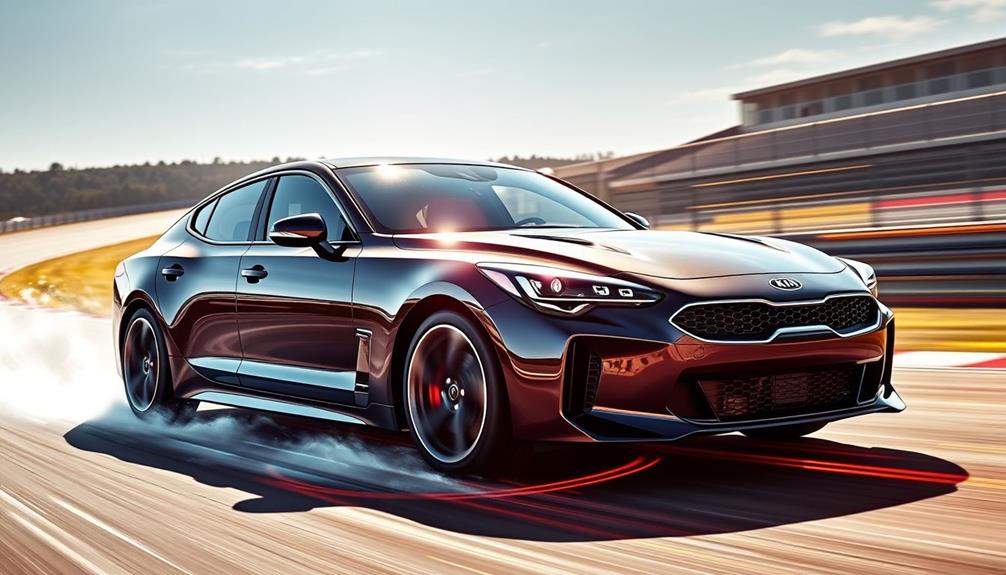
Achieving power gains in the Kia Stinger 3.3T requires an understanding of how various modifications interact with each other.
It's important to recognize that these gains don't increase in a linear fashion; instead, each component contributes differently to your overall performance.
To maximize your Stinger's potential, consider these key factors:
- Air Intake System: Upgrading your air intake can improve airflow, enhancing combustion efficiency.
- Exhaust Modifications: A high-performance exhaust system reduces back pressure, allowing for better engine breathing.
- Tuning Adjustments: Proper tuning, including throttle mapping, is critical for optimizing the interaction between upgrades.
Balancing these elements is fundamental.
Remember, realistic expectations are necessary. The combination of your modifications and the quality of the fuel you use will directly impact horsepower and torque.
To get the most out of your tuning, opt for higher octane fuels, such as 91 octane or above.
This guarantees that your engine operates at peak performance, maximizing the benefits of your enhancements.
Fuel Quality Impact

Fuel quality plays a considerable role in releasing the full potential of your Kia Stinger 3.3T. Using higher octane fuels allows for enhanced tuning, enabling you to achieve greater horsepower and torque gains. In Canada, where 91 octane fuel is common, you might find your tuning options limited, restricting the Stinger's maximum performance enhancements.
| Fuel Type | Octane Rating |
|---|---|
| Regular | 87 |
| Mid-Grade | 89 |
| Premium | 91 |
Without an octane booster, your JB4 tuning may be confined to Map 2, which can hinder your power output compared to utilizing higher octane fuel. Remember, the effectiveness of aftermarket modifications is greatly influenced by fuel quality, making it crucial to choose high-quality fuel.
The overall success of your tuning efforts also relies on the combination of aftermarket parts and the quality of fuel you use. By prioritizing high-octane options, you can maximize your performance upgrades and fully release the potential of your Stinger. Choose wisely to guarantee your tuning experience delivers the results you expect.
Community Experiences

As a Kia Stinger owner, you might be curious about how modifications have transformed others' driving experiences.
Many enthusiasts share valuable insights on performance improvements and effective tuning strategies, but they also highlight the challenges that can arise.
Engaging with the community can help you navigate these hurdles and optimize your own Stinger's performance.
Owner Modification Insights
Kia Stinger owners are enthusiastic to share their experiences and modifications, creating a vibrant community focused on performance enhancements.
If you're looking to boost your Stinger's throttle response and overall performance, you'll find plenty of insights from fellow enthusiasts. Here are three popular modifications that can make a noticeable difference:
- HnN Typhoon Air Intakes: Many owners recommend this modification for improved airflow, essential for increasing the power output of your 3.3T engine.
- JB4 and Uncle Chip Lap3 Performance Chips: Community feedback shows that pairing these chips with other modifications can lead to significant horsepower gains.
- High-Octane Fuel: Owners emphasize the importance of using high-octane fuel. In Canada, 91 octane is a common choice that directly affects tuning effectiveness and overall performance.
Balancing your intake, exhaust, and tuning modifications is key to achieving ideal results.
Engaging with knowledgeable members within the Stinger community can provide additional valuable insights, helping you on your journey to maximize power and speed in your high-performance sedan.
Performance Improvement Strategies
Performance enthusiasts often share valuable strategies for improving the power and handling of the Stinger. One popular combination you'll find in the community involves pairing HnN Typhoon air intakes with performance exhaust systems. Many owners report significant gains, achieving upwards of 335 kW at the flywheel.
Utilizing high-octane fuel is essential too; in Canada, 91 octane is commonly available and can dramatically impact your tuning potential.
Furthermore, the effectiveness of performance modifications like JB4 and Uncle Chip Lap3 can vary based on your engine's current tuning. Some users with AWD configurations report less than 400 WHP, highlighting the importance of a proper ECU tune and throttle mapping. This guarantees that all your upgrades work in harmony for peak performance.
Engaging with knowledgeable community members can provide you with valuable recommendations on tuning strategies and successful parts combinations.
If you're looking to maximize your Stinger's performance, don't hesitate to reach out and contact us. By leveraging shared experiences and proven methods, you can transform your driving experience and reveal your sedan's full potential.
Tuning Challenges Encountered
Achieving your tuning goals with the Kia Stinger can come with its share of hurdles. Many owners have faced tuning challenges that require a solid understanding of modifications and their interactions. It’s essential to approach the tuning process with patience and a focus on the specific components you’re upgrading. While some may compare the process to tuning the Kia Spectra 2008, the Stinger’s more advanced engine and electronics present unique complexities. Proper research and possibly working with professionals knowledgeable in Kia performance modifications can help ensure that you meet your performance goals without compromising reliability.
Here are three common issues you might encounter:
- Combination of Modifications: Significant power gains often depend on multiple upgrades, such as intake systems, exhausts, and ECU tuning. It's essential to choose parts that work harmoniously together.
- Fuel Quality: Finding the right fuel is critical. Most Stinger owners report that using higher octane fuels, like 91 octane, yields better tuning results. Poor fuel can hinder your performance gains.
- Aftermarket Chips: While options like Race Chip may seem appealing, they don't always deliver the expected improvements for the 3.3T engine. You may need to explore alternative tuning methods.
Additionally, issues with throttle mapping can complicate your tuning journey, making precise adjustments necessary for a high-performing driving experience.
Engaging with the community and conducting thorough research can help you navigate these tuning challenges and achieve your desired performance.
Recommended Upgrade Packages

When it comes to enhancing your Stinger's capabilities, you'll find several upgrade packages designed to maximize power and efficiency.
The Stage 2 upgrade package from Horsepower Factory is a fantastic choice for your Stinger GT, featuring a replacement intake manifold and upgraded colder spark plugs to boost power output and throttle response considerably.
For instant gains, consider installing a JB4 tuning system; just keep in mind that it performs best with higher octane fuel—Map 2 works wonders on 91 octane.
To further enhance performance, combining HnN Typhoon air intakes with an MBRP exhaust system will optimize airflow and exhaust efficiency, taking your ride to the next level.
Don't overlook the Ultimate Performance Downpipes, which are essential for the 3.3T engine, allowing for greater power increases when paired with a thorough tuning strategy.
After implementing these modifications, a final dyno run could show around 335 kW at the flywheel, showcasing the significant performance enhancements available.
Frequently Asked Questions
How Much HP Can You Get Out of a Kia Stinger?
You can get around 362 HP from a stock Kia Stinger. With performance modifications, you might achieve less than 400 WHP, depending on upgrades like intakes, exhausts, and tuning chips for ideal results.
What Is the Top Speed of a Kia Stinger 3.3 V6?
Imagine cruising in a time machine; you'd feel the thrill of the Kia Stinger 3.3 V6 hitting a top speed of about 167 mph. It's a beast, combining power and speed effortlessly. Enjoy the ride!
What Is the Best Driving Mode for Kia Stinger?
If you want a dynamic driving experience, use Sport mode. It enhances throttle response and optimizes suspension. For everyday commuting, switch to Comfort mode, prioritizing a smoother ride while Smart mode adjusts automatically based on your driving.
How Much Horsepower Does a Kia Stinger 3.3 Have?
You'll find the Kia Stinger 3.3 boasts around 362 horsepower from its 3.3L V6 twin-turbo engine. With performance upgrades, this can rise considerably, potentially reaching about 448 horsepower at the flywheel.
Conclusion
So, if you want your Kia Stinger 3.3 to roar like a lion instead of humming like a kitten, it's time to embrace the tuning world. Sure, you could just enjoy your comfy ride, but where's the fun in that? Why settle for "nice" when you could have "absolutely insane"? Immerse yourself in those performance modifications and fuel upgrades—your sedan deserves a wild side, after all. Let's face it, who wouldn't want to be the fastest car in the grocery store parking lot?



